Wikipedia:Picture of the day/November 2021
|
Featured picture tools: |
These featured pictures, as scheduled below, appeared as the picture of the day (POTD) on the English Wikipedia's Main Page in November 2021. Individual sections for each day on this page can be linked to with the day number as the anchor name (e.g. [[Wikipedia:Picture of the day/November 2021#1]] for November 1).
You can add an automatically updating POTD template to your user page using {{Pic of the day}} (version with blurb) or {{POTD}} (version without blurb). For instructions on how to make custom POTD layouts, see Wikipedia:Picture of the day.
November 1

|
|
Stereoscopy is a technique for creating or enhancing the illusion of depth in an image by means of stereopsis for binocular vision. This image of two Passiflora caerulea flowers is arranged as a stereo image pair; it can be viewed stereoscopically by using the cross-eyed viewing method (parallel version here). Photograph credit: Franz van Duns
Recently featured:
|
November 2
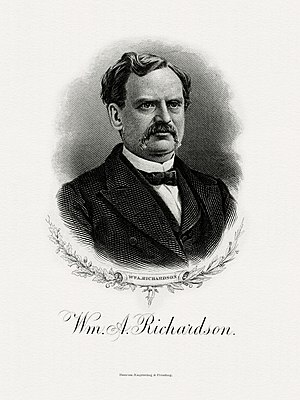
|
William Adams Richardson (November 2, 1821 – October 19, 1896) was an American lawyer who served as the 29th United States secretary of the treasury from 1873 to 1874. During his tenure, the Panic of 1873 swept the nation and caused a depression that lasted five years. He controversially responded by issuing $26 million in greenbacks, which averted the crisis, although there was debate as to whether he had the authority to do so. He was later appointed a judge, and subsequently the chief justice, of the Court of Claims. This line engraving of Richardson was produced around 1902 by the Department of the Treasury's Bureau of Engraving and Printing (BEP) as part of a BEP presentation album of the first 42 secretaries of the treasury. Engraving credit: Bureau of Engraving and Printing; restored by Andrew Shiva
Recently featured:
|
November 3

|
Anne Dallas Dudley (November 13, 1876 – September 13, 1955) was a prominent activist in the women's suffrage movement in the United States. In 1917, she became the third vice president of the National American Woman Suffrage Association, where she contributed significantly to advancing legislation on the issue of women's suffrage. In 1920, along with several others, she led the campaign in Tennessee to approve ratification of the Nineteenth Amendment to the US Constitution. As a result, Tennessee became the 36th and deciding state to ratify the amendment, thereby giving women the right to vote throughout the country. Photograph credit: Bain News Service
Recently featured:
|
November 4
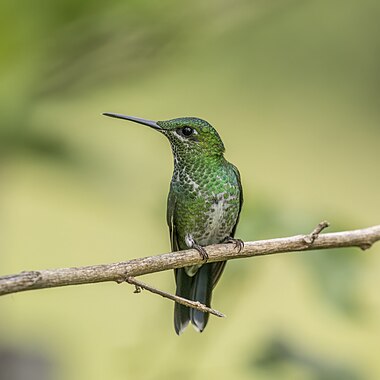
|
The green-crowned brilliant (Heliodoxa jacula) is a large hummingbird native to the highlands from Costa Rica to western Ecuador where it lives at altitudes of between 700 and 2,000 m (2,300 and 6,600 ft). It feeds at the large inflorescences of Marcgravia vines, which the male will sometimes defend, and will also feed at Heliconia and other large flowers. Unlike many hummingbirds, the green-crowned brilliant almost always perches to feed. This female, subspecies H. j. henryi, was photographed in the Mount Totumas cloud forest, Panama. Photograph credit: Charles James Sharp
Recently featured:
|
November 5

|
Fort Ross is a former Russian establishment on the west coast of North America in present-day Sonoma County, California. It was established in 1812 by the Russian-American Company to act as an agricultural base from which the Russian settlements in North America could be supplied with food and trade with Spanish Alta California. By 1841, the settlement was no longer needed for that purpose and was sold. The fort became a National Historic Landmark on November 5, 1961, and is part of California's Fort Ross State Historic Park. This photograph shows the Russian Orthodox Holy Trinity St. Nicholas Chapel at Fort Ross, which was rebuilt in 1973 after a fire. Photograph credit: Frank Schulenburg
Recently featured:
|
November 6
Subpage 1

|
Banknotes of Demerary and Essequibo were issued by the British colonies of Demerara and Essequibo from 1809 through 1839. They were dual-denominated in Guilders and Joes, a term used by the British colonists to refer to the Portuguese gold Johannes coin and the notes that eventually replaced them. Despite roughly 30 years of use, the only Joe notes known to exist are unissued remainders from the 1830s; this one-Joe banknote forms part of the National Numismatic Collection at the Smithsonian Institution. Banknote design credit: Kingdom of Great Britain for British Guiana; photographed by Andrew Shiva
Recently featured:
|
Subpage 2

|
Banknotes of Demerary and Essequibo were issued by the British colonies of Demerara and Essequibo from 1809 through 1839. They were dual-denominated in Guilders and Joes, a term used by the British colonists to refer to the Portuguese gold Johannes coin and the notes that eventually replaced them. Despite roughly 30 years of use, the only Joe notes known to exist are unissued remainders from the 1830s; this two-Joe banknote forms part of the National Numismatic Collection at the Smithsonian Institution. Banknote design credit: Kingdom of Great Britain for British Guiana; photographed by Andrew Shiva
Recently featured:
|
Subpage 3

|
Banknotes of Demerary and Essequibo were issued by the British colonies of Demerara and Essequibo from 1809 through 1839. They were dual-denominated in Guilders and Joes, a term used by the British colonists to refer to the Portuguese gold Johannes coin and the notes that eventually replaced them. Despite roughly 30 years of use, the only Joe notes known to exist are unissued remainders from the 1830s; this three-Joe banknote forms part of the National Numismatic Collection at the Smithsonian Institution. Banknote design credit: Kingdom of Great Britain for British Guiana; photographed by Andrew Shiva
Recently featured:
|
Subpage 4
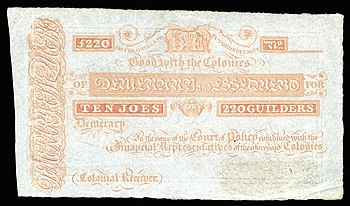
|
Banknotes of Demerary and Essequibo were issued by the British colonies of Demerara and Essequibo from 1809 through 1839. They were dual-denominated in Guilders and Joes, a term used by the British colonists to refer to the Portuguese gold Johannes coin and the notes that eventually replaced them. Despite roughly 30 years of use, the only Joe notes known to exist are unissued remainders from the 1830s; this ten-Joe banknote forms part of the National Numismatic Collection at the Smithsonian Institution. Banknote design credit: Kingdom of Great Britain for British Guiana; photographed by Andrew Shiva
Recently featured:
|
Subpage 5

|
Banknotes of Demerary and Essequibo were issued by the British colonies of Demerara and Essequibo from 1809 through 1839. They were dual-denominated in Guilders and Joes, a term used by the British colonists to refer to the Portuguese gold Johannes coin and the notes that eventually replaced them. Despite roughly 30 years of use, the only Joe notes known to exist are unissued remainders from the 1830s; this twenty-Joe banknote forms part of the National Numismatic Collection at the Smithsonian Institution. Banknote design credit: Kingdom of Great Britain for British Guiana; photographed by Andrew Shiva
Recently featured:
|
November 7

|
Hypomeces squamosus, commonly known as the gold-dust weevil or green weevil, is a species of beetle in the family Curculionidae. The adult weevil can reach a length of about 14 mm (0.6 in) and is covered with iridescent green or yellowish-green dust-like scales. This species can be found in India, tropical Southeast Asia, and the Philippines. Both the larvae and adults are crop pests, the larvae feeding on plant roots and the adults chewing leaves. This picture of an adult weevil is a digital montage based on five different photographs, using a focus stacking technique. Photograph credit: Basile Morin
Recently featured:
|
November 8

|
Cortina d'Ampezzo is a town in the heart of the southern (Dolomitic) Alps in the region of Veneto in northern Italy. Situated on the river Boite, in an alpine valley, it is a summer and winter sports resort. Seen here in late summer from Mount Faloria with the peaks of Tofane in the background, Cortina d'Ampezzo hosted the 1956 Winter Olympics and the FIS Alpine World Ski Championships 2021, and, jointly with Milan, is scheduled to host the 2026 Winter Olympics and the 2026 Winter Paralympics. Photograph credit: Kallerna
Recently featured:
|
November 9

|
Fredrikke Mørck (9 November 1861 – 14 October 1934) was a Norwegian feminist, editor and school teacher. Born in Trondheim, she started her own school, Fredrikke Mørcks Pigeskole, around 1905. She contributed to the feminist magazine Nylænde from its inception in 1893, and served as its editor from 1916 to 1927. Mørck chaired the Norwegian Association for Women's Rights from 1926 to 1930. Photograph credit: unknown; restored by Adam Cuerden
Recently featured:
|
November 10

|
Landscape near Arles is an 1888 oil-on-canvas by the French artist Paul Gauguin. It depicts a rural scene in Provence, southern France, featuring a haystack with a traditional farmhouse and cypress trees in the background. At the time, Gauguin was living with Vincent van Gogh in Arles; they had a stormy relationship, but it proved to be a productive period for both artists. The painting is in the collection of the Indianapolis Museum of Art. Painting credit: Paul Gauguin
Recently featured:
|
November 11

|
Nelly Martyl (1884–1953) was a French opera singer. She sang in the premieres of several operas, including Leborne's La Catalane (1907), Erlanger's La Sorcière (1912), and Massenet's Amadis (1922). Martyl joined the Red Cross as a nurse during the First World War, and served at the Battle of Verdun in 1916, where she was known as la fée de Verdun (the Fairy of Verdun), and at the Second Battle of the Aisne in 1917. She continued as a nurse after the war to help with the 1918 epidemic of Spanish flu. She was awarded the Croix de Guerre with the carte du combattant (signifying service under particular hazard) in 1920. Photograph credit: Jean Reutlinger; restored by Adam Cuerden
Recently featured:
|
November 12

|
The saddle-billed stork (Ephippiorhynchus senegalensis) is a large wading bird in the stork family, Ciconiidae. The species has a widespread distribution in sub-Saharan Africa, and feeds on fish, frogs, crabs and other small creatures. This saddle-billed stork was photographed fishing in the shallow waters of the Okavango Delta in Botswana. Photograph credit: Diego Delso
Recently featured:
|
November 13

|
John A. Dahlgren (November 13, 1809 – July 12, 1870) was a United States Navy officer who founded the Navy's Ordnance Department and launched major advances in gunnery. He introduced a cast-iron muzzle-loading cannon with vastly increased range and accuracy, known as the Dahlgren gun, which became the Navy's standard armament. During the American Civil War, he was made the commander of the Washington Navy Yard. He also served at sea, being put in command of the South Atlantic Blockading Squadron. Photograph credit: Mathew Brady; restored by Jebulon
Recently featured:
|
November 14

|
La Esmeralda is a grand opera in four acts composed by Louise Bertin, an adaptation of the French Gothic novel The Hunchback of Notre-Dame by Victor Hugo, who also wrote the libretto for the opera. This sketch by Charles-Antoine Cambon shows the set design for act 3, scene 2, of the opera, which premiered at the Théâtre de l'Académie Royale de Musique in Paris on 14 November 1836. Set design credit: Charles-Antoine Cambon; restored by Adam Cuerden
Recently featured:
|
November 15

|
The Capitolium of Brixia was the main temple in the center of the Roman town of Brixia (Brescia) in northern Italy. All that remains is fragmentary ruins, but the temple is part of an archeological site, including a Roman amphitheatre and museum in central Brescia. It forms part of the Longobards in Italy: Places of Power (568–774 A.D.), a UNESCO World Heritage Site inscribed in 2011. Photograph credit: Wolfgang Moroder
Recently featured:
|
November 16

|
The cheetah (Acinonyx jubatus) is a large cat native to Africa and central Iran. Cubs are highly vulnerable to predators during the first few weeks of life, and predation is the leading cause of mortality among cheetah cubs. A study showed that in areas with a low density of predators (such as Namibian farmlands) around 70 per cent of the cubs survived beyond the age of 14 months, whereas in areas like the Serengeti National Park, where several large carnivores exist, the survival rate was just 17 per cent. This cheetah cub was photographed in the Phinda Private Game Reserve in KwaZulu-Natal, South Africa, amid long grass. Photograph credit: Charles James Sharp
Recently featured:
|
November 17

|
Georg Braun (1541 – 10 March 1622) was a Catholic cleric and topo-geographer from Cologne. From 1572 to 1617, he edited the Civitates orbis terrarum, which contains 546 prospects, bird's-eye views and maps of cities from around the world. This copper plate print was published in the first volume of the work; it was engraved by the Flemish mapmaker Frans Hogenberg and shows a historical view of Trier. Credit: Frans Hogenberg and Georg Braun
Recently featured:
|
November 18

|
The Utah monolith was a three-meter-tall (9.8 ft) metal pillar that stood in a red sandstone slot canyon in northern San Juan County in the U.S. state of Utah. Made of metal sheets riveted into a triangular prism, it was unlawfully placed on public land between July and October 2016, and stood unnoticed for more than four years until its discovery and removal in late 2020. The identity of its makers, and their objectives, are unknown. Following its discovery, numerous similar metal columns, many of which were built by local artists as deliberate imitations, were erected in other places throughout the world. This photograph shows the Utah monolith at its original location. Photograph credit: Patrick A. Mackie; retouched by Chainwit.
Recently featured:
|
November 19

|
Alan Bean (1932–2018) was an American naval officer, naval aviator, aeronautical engineer, test pilot, and NASA astronaut. During the Apollo 12 mission, on 19–20 November 1969, he became the fourth person to walk on the Moon. This portrait photograph, taken by NASA two months before the mission, depicts Bean beside a mock-up of the Apollo Lunar Module, wearing his space suit without the helmet and gloves. Photograph credit: NASA / Johnson Space Center
Recently featured:
|
November 20

|
The ruddy turnstone (Arenaria interpres) is a small wading bird in the sandpiper family, Scolopacidae. It is a highly migratory bird, breeding in northern parts of Eurasia and North America and flying south to winter on coastlines almost worldwide. This adult ruddy turnstone in non-breeding plumage was photographed at Boat Harbour in New South Wales, Australia. Photograph credit: John Harrison
Recently featured:
|
November 21

|
The Sainte-Chapelle de Vincennes is a Gothic royal chapel within the fortifications of the Château de Vincennes on the east edge of Paris. It was inspired by the Sainte-Chapelle, the royal chapel within the Palais de la Cité in Paris. It was begun in 1379 by Charles V of France to house relics of the Passion of Jesus. The interior, seen in this photograph, has very little decoration, most of it having been destroyed in 1793 during the French Revolution, but vestiges of the sculpture and portions of the Renaissance stained glass remain. Photograph credit: Daniel Vorndran
Recently featured:
|
November 22

|
Baby Huwae (22 November 1939 – 5 June 1989) was an Indonesian model, film actress and singer. Born in Rotterdam, Netherlands, she moved to Indonesia, where she took up modelling, by the 1950s. She entered the film industry in 1958, and gained popularity following the success of Asrama Dara. Over the next few years, Huwae acted in a further five films and established a girl group, the Baby Dolls, with several actresses who had appeared in her second film. She made a guest appearance in one more film in 1971 after a ten-year hiatus. Photograph credit: Tati Photo Studio; restored by Chris Woodrich
Recently featured:
|
November 23
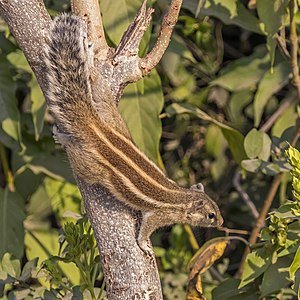
|
The northern palm squirrel (Funambulus pennantii) is a species of rodent in the family Sciuridae. It has a wide distribution in the Indian subcontinent and Iran, being a semi-arboreal species found in dry deciduous forest and many other rural and urban habitats. It is a common species with a wide range and the International Union for Conservation of Nature has rated its conservation status as being of least concern. This northern palm squirrel was photographed in Keoladeo National Park in Bharatpur, in the Indian state of Rajasthan. Photograph credit: Charles James Sharp
Recently featured:
|
November 24

|
Eswatini, formerly known as Swaziland, is a landlocked country in Southern Africa. The government is an absolute monarchy, the last of its kind in Africa, and the country has been ruled by King Mswati III since 1986. One of the country's important cultural events is Umhlanga, the reed-dance festival, held in August or September each year. This photograph shows Princess Sikhanyiso Dlamini, the eldest daughter of Mswati III, at the 2006 festival. Photograph credit: Amada44
Recently featured:
|
November 25
Subpage 1
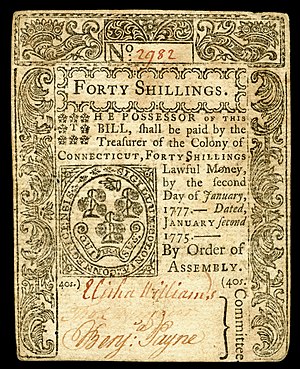
|
Early American currency went through several stages of development during the colonial and post-Revolutionary history of the United States. During the American Revolution, the Colonies became independent states. No longer subject to arbitrarily imposed monetary regulations by the British Parliament, the States began to issue paper money, to pay for military expenses. This forty shillings banknote was issued by the Colony of Connecticut, dated 2 January 1775; it is part of the National Numismatic Collection at the Smithsonian Institution. Other issues:
Banknote design credit: Colony of Connecticut and Timothy Green (printer); photographed by Andrew Shiva
Recently featured:
|
Subpage 2

|
Early American currency went through several stages of development during the colonial and post-Revolutionary history of the United States. During the American Revolution, the Colonies became independent states. No longer subject to arbitrarily imposed monetary regulations by the British Parliament, the States began to issue paper money, to pay for military expenses. This four shillings banknote was issued by the Delaware Colony and is dated 1 January 1776; it is part of the National Numismatic Collection at the Smithsonian Institution. Other issues:
Banknote design credit: Delaware Colony and James Adams (printer); photographed by Andrew Shiva
Recently featured:
|
Subpage 3

|
Early American currency went through several stages of development during the colonial and post-Revolutionary history of the United States. During the American Revolution, the Colonies became independent states. No longer subject to arbitrarily imposed monetary regulations by the British Parliament, the States began to issue paper money, to pay for military expenses. This forty dollar banknote was issued by the state of Georgia and is dated 4 May 1778; it is part of the National Numismatic Collection at the Smithsonian Institution. Other issues:
Banknote design credit: State of Georgia and W. Lancaster (printer); photographed by Andrew Shiva
Recently featured:
|
Subpage 4

|
Early American currency went through several stages of development during the colonial and post-Revolutionary history of the United States. During the American Revolution, the Colonies became independent states. No longer subject to arbitrarily imposed monetary regulations by the British Parliament, the States began to issue paper money, to pay for military expenses. This one dollar banknote was issued by the Province of Maryland and is dated 1 March 1770; it is part of the National Numismatic Collection at the Smithsonian Institution. Other issues:
Banknote design credit: Province of Maryland and Anne Catherine & William Green (printers); photographed by Andrew Shiva
Recently featured:
|
Subpage 5

|
Early American currency went through several stages of development during the colonial and post-Revolutionary history of the United States. During the American Revolution, the Colonies became independent states. No longer subject to arbitrarily imposed monetary regulations by the British Parliament, the States began to issue paper money, to pay for military expenses. This two shillings banknote was issued by the Province of Massachusetts Bay and is dated 1 May 1741; it is part of the National Numismatic Collection at the Smithsonian Institution. Other issues:
Banknote design credit: Province of Massachusetts Bay; photographed by Andrew Shiva
Recently featured:
|
Subpage 6

|
Early American currency went through several stages of development during the colonial and post-Revolutionary history of the United States. During the American Revolution, the Colonies became independent states. No longer subject to arbitrarily imposed monetary regulations by the British Parliament, the States began to issue paper money, to pay for military expenses. This one dollar banknote was issued by the state of New Hampshire and is dated 29 April 1780; it is part of the National Numismatic Collection at the Smithsonian Institution. Other issues:
Banknote design credit: Province of New Hampshire, printed by Hall & Sellers; photographed by Andrew Shiva
Recently featured:
|
Subpage 7

|
Early American currency went through several stages of development during the colonial and post-Revolutionary history of the United States. During the American Revolution, the Colonies became independent states. No longer subject to arbitrarily imposed monetary regulations by the British Parliament, the States began to issue paper money, to pay for military expenses. This twelve shillings banknote was issued by the Colony of New-Jersey and is dated 25 March 1776; it is part of the National Numismatic Collection at the Smithsonian Institution. Other issues:
Banknote design credit: Colony of New Jersey and I. Collins (printer); photographed by Andrew Shiva
Recently featured:
|
Subpage 8

|
Early American currency went through several stages of development during the colonial and post-Revolutionary history of the United States. During the American Revolution, the Colonies became independent states. No longer subject to arbitrarily imposed monetary regulations by the British Parliament, the States began to issue paper money, to pay for military expenses. This two shillings banknote was issued by the Colony of New-York and is dated 2 August 1775; it is part of the National Numismatic Collection at the Smithsonian Institution. Other issues:
Banknote design credit: Colony of New York and H. Gaine (printer); photographed by Andrew Shiva
Recently featured:
|
Subpage 9

|
Early American currency went through several stages of development during the colonial and post-Revolutionary history of the United States. During the American Revolution, the Colonies became independent states. No longer subject to arbitrarily imposed monetary regulations by the British Parliament, the States began to issue paper money, to pay for military expenses. This three pounds banknote was issued by the Province of North Carolina, dated 27 November 1729; it is part of the National Numismatic Collection at the Smithsonian Institution. Other issues:
Banknote design credit: Province of North Carolina; photographed by Andrew Shiva
Recently featured:
|
Subpage 10

|
Early American currency went through several stages of development during the colonial and post-Revolutionary history of the United States. During the American Revolution, the Colonies became independent states. No longer subject to arbitrarily imposed monetary regulations by the British Parliament, the States began to issue paper money, to pay for military expenses. This twenty shillings banknote was issued by the Province of Pennsylvania, dated 20 March 1771; it is part of the National Numismatic Collection at the Smithsonian Institution. Other issues:
Banknote design credit: Province of Pennsylvania, Printed by D. Hall & W. Sellers; photographed by Andrew Shiva
Recently featured:
|
Subpage 11

|
Early American currency went through several stages of development during the colonial and post-Revolutionary history of the United States. During the American Revolution, the Colonies became independent states. No longer subject to arbitrarily imposed monetary regulations by the British Parliament, the States began to issue paper money, to pay for military expenses. This one dollar banknote was issued by the State of Rhode-Island and Providence Plantations, dated 2 July 1780; it is part of the National Numismatic Collection at the Smithsonian Institution. Other issues:
Banknote design credit: State of Rhode Island and Providence Plantations, Printed by D. Hall & W. Sellers; photographed by Andrew Shiva
Recently featured:
|
Subpage 12

|
Early American currency went through several stages of development during the colonial and post-revolutionary history of the United States. During the American Revolution, the colonies became independent states. No longer subject to arbitrarily imposed monetary regulations by the British Parliament, the states began to issue paper money, to pay for military expenses. This sixty dollars banknote was issued by the state of South Carolina, dated 8 February 1779; it is part of the National Numismatic Collection at the Smithsonian Institution. Other issues:
Banknote design credit: South Carolina, engraved by Thomas Coram; photographed by Andrew Shiva
Recently featured:
|
Subpage 13

|
Early American currency went through several stages of development during the colonial and post-revolutionary history of the United States. During the American Revolution, the colonies became independent states. No longer subject to arbitrarily imposed monetary regulations by the British Parliament, the states began to issue paper money, to pay for military expenses. This three pounds banknote was issued by the Colony of Virginia, dated 4 March 1773; it is part of the National Numismatic Collection at the Smithsonian Institution. Other issues:
Banknote design credit: Colony of Virginia, engraved by Henry Ashby; photographed by Andrew Shiva
Recently featured:
|
November 26

|
Purana tigrina is a species of cicada found in Southeast Asia. This adult male was photographed in Kadavoor, Kerala, in southern India, and is about one inch (25 mm) in length. The mouthparts are adapted to piercing plant tissues and sucking sap; the male abdomen houses the tymbal, an organ used in the production of song, while the female abdomen is tipped by a large, saw-edged ovipositor. Photograph credit: Jeevan Jose
Recently featured:
|
November 27

|
|
Cygnus is a northern constellation on the plane of the Milky Way, deriving its name from the Latinized Greek word for 'swan'. Cygnus is one of the most recognizable constellations of the northern summer and autumn, and it features a prominent asterism known as the Northern Cross. Cygnus was among the 48 constellations listed by the 2nd-century astronomer Ptolemy, and it remains one of the 88 modern constellations. This illustration of Cygnus, with the surrounding constellations of Lacerta, Lyra and Vulpecula, was produced around 1823 as part of Urania's Mirror, a set of 32 astronomical star-chart cards published in the United Kingdom. Lithograph credit: Sidney Hall; restored by Adam Cuerden
Recently featured:
|
November 28

|
|
A Meeting in the Royal Danish Academy of Sciences and Letters is a monumental 1897 oil-on-canvas group portrait by Peder Severin Krøyer, depicting the membership of the Royal Danish Academy of Sciences and Letters during one of its meetings in the Prince's Mansion in Copenhagen. Commissioned by the Carlsberg Foundation, the painting measures 266.7 by 519.4 centimetres (105.0 in × 204.5 in), and hangs in the Academy's building in central Copenhagen. Painting credit: Peder Severin Krøyer
Recently featured:
|
November 29

|
The Walchensee Hydroelectric Power Station is a storage power station in Bavaria, Germany. The turbines, seen here, are fed by water from the Walchensee which is then released into the Kochelsee. The power station uses the hydraulic head of about 200 metres (660 ft) between the two natural lakes, and water from the Rißbach river is also used to augment the supply. The installed capacity is 124 MW with an annual production of 300 GWh; this is one of the largest of such power plants in Germany. Photograph credit: Diego Delso
Recently featured:
|
November 30

|
Henry Taube (November 30, 1915 – November 16, 2005) was a Canadian-born American chemist who was awarded the 1983 Nobel Prize in Chemistry for "his work in the mechanisms of electron-transfer reactions, especially in metal complexes". He was the second Canadian-born chemist to win the Nobel Prize, and remains the only Saskatchewanian-born Nobel laureate. Taube also received many other major scientific awards, including the Priestley Medal in 1985 and two Guggenheim Fellowships early in his career (1949 and 1955), as well as numerous honorary doctorates. Photograph credit: United States Department of Energy; restored by Bammesk |
Picture of the day archives and future dates
